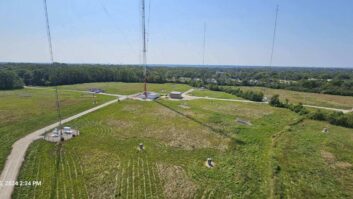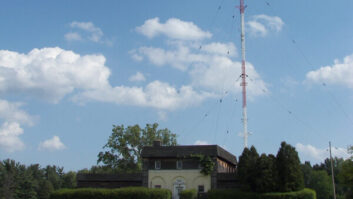Bill Sullivan’s case of line and copper theft, discussed in the previous Workbench, has raised site awareness – especially when it comes to access.
Consider Fig. 1. The tower base looks protected and secure enough with the stockade fence. That is, until you walk around the other side, seen in Fig. 2.
It gets worse. When you get around to the back … well, who needs a gate?
Not only is this an open invitation to cable and ground strap theft, there is the potential shock hazard or law suit – or if this is seen by an FCC inspector, a fine on the spot.
Let these pictures be a lesson to you contract guys who are inspecting a station for a potential buyer. Due diligence means just that. Be diligent. Visit every tower.

Fig. 1: What appears to be a secure tower fence …

Fig. 2: … isn’t what it seems.

Fig. 3: These are reasons to walk your transmitter site periodically … and completely. The pictures remind me of a site I inspected years ago for a buyer. The field was filled with sharp, thorny brambles that grew about knee-high. Off in the distance were three newly painted tower fences.
Against the owner’s wishes – he said I was wasting my time – I walked out to the bases of each tower. I’m glad I did. The rear and sides of the fencing were dilapidated, looking a lot like Fig. 3.
Worse, the site was 50 kW. Some very lethal voltages were present across those base insulators.
Yes, I got cut up by the brambles, but nowhere near as cut up as I’d have been if I hadn’t taken that run-around. The moral to this story: Assume nothing, take nothing for granted.
Thanks to our mystery contract engineer for sharing the photos.
* * *
Hal Schardin works with Minnesota Radio Talking Books and in that capacity maintains many satellite receive dishes around the state for program distribution.
When one of his locations failed, Hal was armed with replacement equipment. Upon arrival, he discovered that the loss of satellite reception was due to bees nesting in the feed horn. A shot of bee killer and a little work restored satellite reception, but he wanted to make sure this didn’t happen again.
Hal purchased a plastic feed horn throat cover from Dawn Satellite only to discover it would not fit the brand of feed horn MRTB was using. Next he considered PVC plumbing caps, but was unsure what size would be the closest and how he would mount the cap.
He considered other forms of plastic. Hal sought a material that was easy to install, that would not attenuate C band signals or get brittle in the Minnesota winters, one that would resist deterioration by the sun and weather. The commercial replacement cap had holes in it, so whatever material he picked, it would need to breathe.
The material Hal chose was Tyvek brand house wrap. He picked up more than a lifetime supply of Tyvek at a local lumber store for a few dollars. Hal used multiple small stainless-steel band clamps (hose clamps) in series to circle and fasten the Tyvek to the feed horn. The materials are shown in Fig. 4, including the blue plastic cap, which wasn’t used.

Fig. 4: Hal Schardin’s bee-stopper consists of house wrap and hose clamps to hold the wrap in place around the satellite feed horn.

Fig. 5: The completed feed horn assembly is sealed against insects and weather. Since the original installation, Hal located a 7 inch band clamp in the HVAC section of a large home builders store chain. This repair has been in use for many years now, and has held up with no problems. The finished cover is seen in Fig. 5.
Now is the time bees sense the change of seasons. A little preventive maintenance can keep you on the air.
Are you a contract guy? Figure out your costs for implementing this fix and offer the “Bee Stopper” to your contract clients. They can pay for the modification now – or they can pay you later when they are off the air while you remove the bees and then install the covering.
Most smart station owners will see the value of this preventive maintenance. Plus, offering this kind of value-added service to your clients helps them understand your focus is on keeping them on the air – not just putting out fires.
Thank you Hal for a great tip to keep stations on the air, and reduce the potential for engineers getting stung.
John Bisset has worked as a chief engineer and contract engineer for 39 years. He is international sales manager for Europe and Southern Africa for Nautel and a former recipient of the SBE’s Educator of the Year Award. Reach him at[email protected]. Faxed submissions can be sent to (603) 472-4944.
Submissions for this column are encouraged and qualify for SBE recertification credit.







